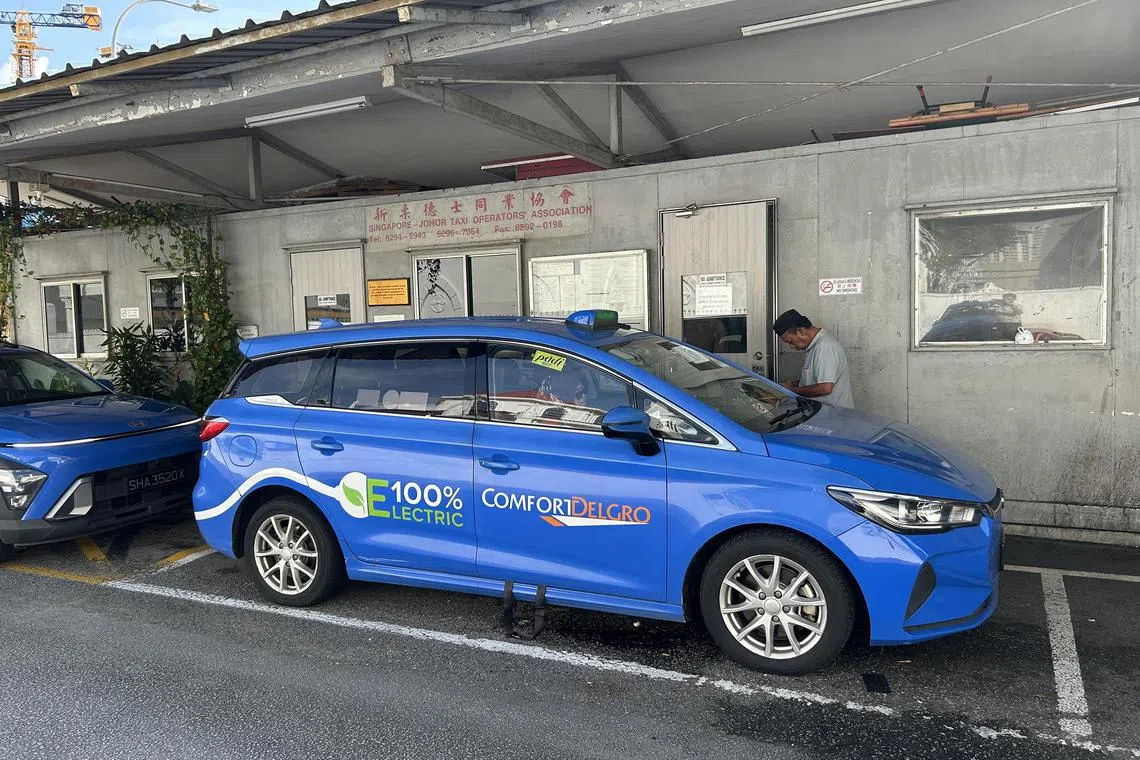ERP 2.0 could be used to prevent illegal cross-border taxi services in Singapore
Sign up now: Get ST's newsletters delivered to your inbox

Licensed cross-border taxis from Singapore or Malaysia can pick up and drop off passengers only at a designated point in the other country.
ST PHOTO: LEE NIAN TJOE
Follow topic:
- Singapore and industry associations discussed using ERP 2.0 location tracking to enforce cross-border taxi service rules and combat illegal operators.
- Current cross-border taxi services need improvements like more pick-up points, higher quotas, larger vehicles, and app-based bookings, according to LTA.
- NPHVA proposed fair standards, passenger matching, public transport lane access, and consistent vehicle regulations for Singapore and Malaysia.
AI generated
SINGAPORE – Illegal trips by cross-border taxis in Singapore could be curbed using location tracking under the next-generation Electronic Road Pricing (ERP 2.0) system.
This possibility was raised at a meeting between the authorities and industry associations last week, during which participants discussed regulations and improvements to such services, including how to keep illegal vehicles from taking away the livelihoods of drivers here.
Since 2023, Singapore-registered vehicles have progressively been fitted with on-board units (OBUs), which can track their locations under ERP 2.0. But Malaysian vehicles entering Singapore are not currently required to have an OBU fitted.
The meeting included representatives from the National Taxi Association (NTA), National Private Hire Vehicles Association (NPHVA) and the Singapore-Johor Taxi Operators’ Association.
Acting Transport Minister Jeffrey Siow, Senior Minister of State for Transport Sun Xueling and officials from the Land Transport Authority (LTA) were also present.
In a Facebook post on Sept 2, LTA said participants in the meeting highlighted the matter of existing cross-border taxi services not being able to meet the demands of large families with young children, seniors and business travellers.
“There are Singaporeans willing to pay for these services, and Singaporean drivers who are keen and able to serve this demand,” it said.
Under the existing reciprocal cross-border taxi scheme, a licensed fleet of up to 200 taxis from each side can ferry passengers between Singapore and Johor Bahru. These taxis can pick up and drop off passengers at only a designated point in the other country – Larkin Sentral in Johor Bahru for Singapore taxis, and Ban San Street Terminal in Singapore for Malaysian taxis.
“We recognised that the current cross-border scheme can be improved, such as designating more pick-up and drop-off points, and facilitating expedited clearance. We discussed expanding the current cross-border taxi schemes to allow higher quotas and larger-capacity vehicles, and partnering platform companies for app-based bookings,” said LTA.
It also pledged to sustain enforcement efforts against foreign vehicles that flout the law.
Separately, on Sept 2, the NPHVA and NTA said illegal point-to-point services that operate across the border create unfair competition and pose safety risks.
In their Facebook posts, the groups said solutions to improve cross-border services have to address the “uneven operating environment due to different car prices, business costs, exchange rates and cost of living”.
Elaborating on suggestions raised at the meeting, both groups said they wanted better passenger matching through ride-hailing apps, more drop-off and pick-up points, and allowing taxis to use public transport lanes to speed up clearance.
They proposed that taxis be allowed to drop off passengers anywhere, while still picking passengers up from only designated points. They said: “This will maintain regulatory oversight while maximising passenger convenience.”
They also proposed that cross-border vehicles share common regulatory standards, such as maximum vehicle age and window tinting limits.
Taxis in Singapore can be used for only up to 10 years, while there are no such limits on Malaysian taxis. Rules on window tinting differ between the countries.
NPHVA also asked that all vehicles display active fare meters and provide receipts “for fair pricing and transparency”.
“Supporting local taxi drivers benefits Singapore’s economy while maintaining workers’ livelihoods, service standards and safety. Our drivers provide reliable service through their local knowledge, established safety protocols and proper insurance coverage for passengers,” NPHVA added.
Efforts to clamp down on illegal transport services have been stepped up recently, following complaints from drivers.
Between 2022 and July 2025, 136 drivers were caught for providing illegal cross-border transport services and their foreign-registered vehicles impounded.
Singapore and Malaysian officials have also met to discuss cross-border service arrangements.
On Aug 3, LTA said no decision was made after the issue of cross-border ride-hailing services was raised during a meeting with its Malaysian counterpart. It added that there were no plans to fully liberalise cross-border point-to-point transport via ride-hailing services.


